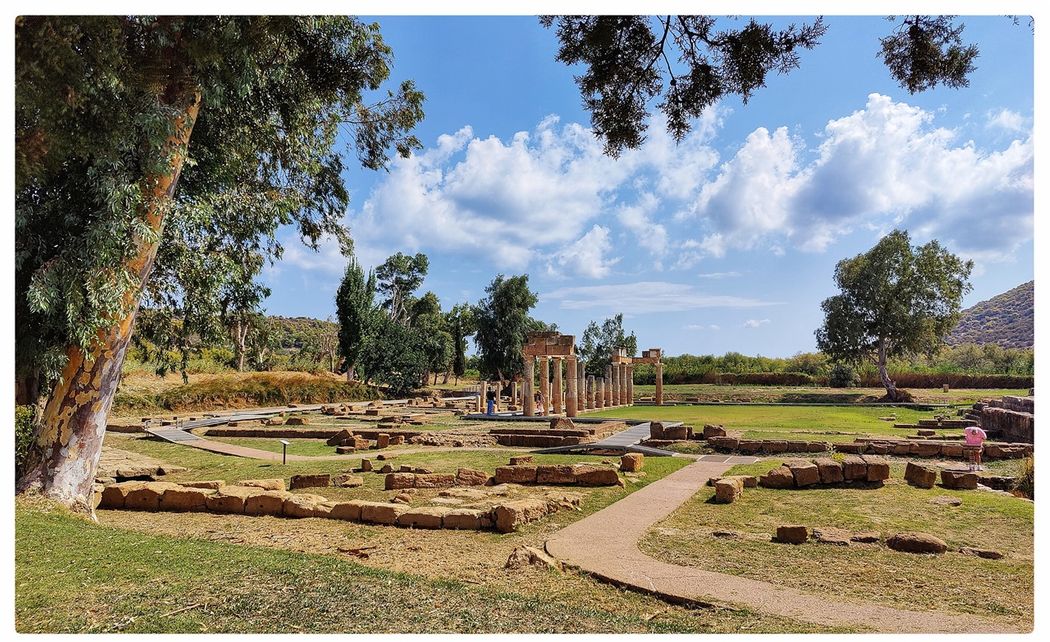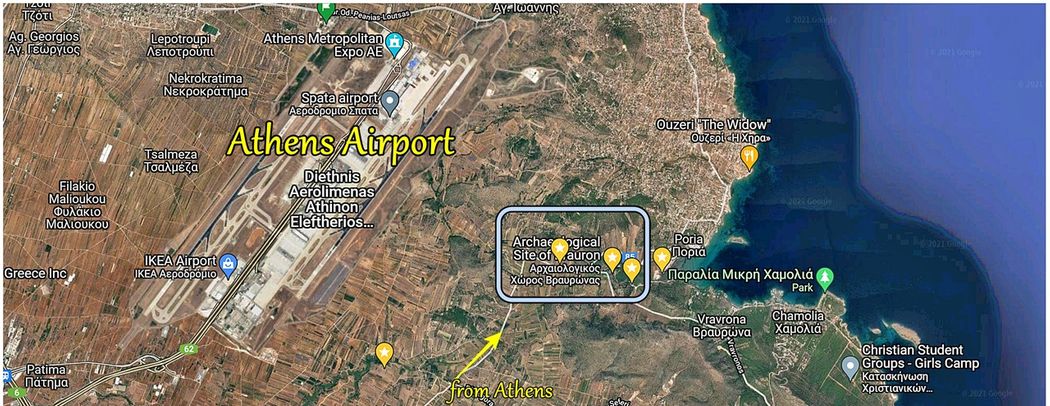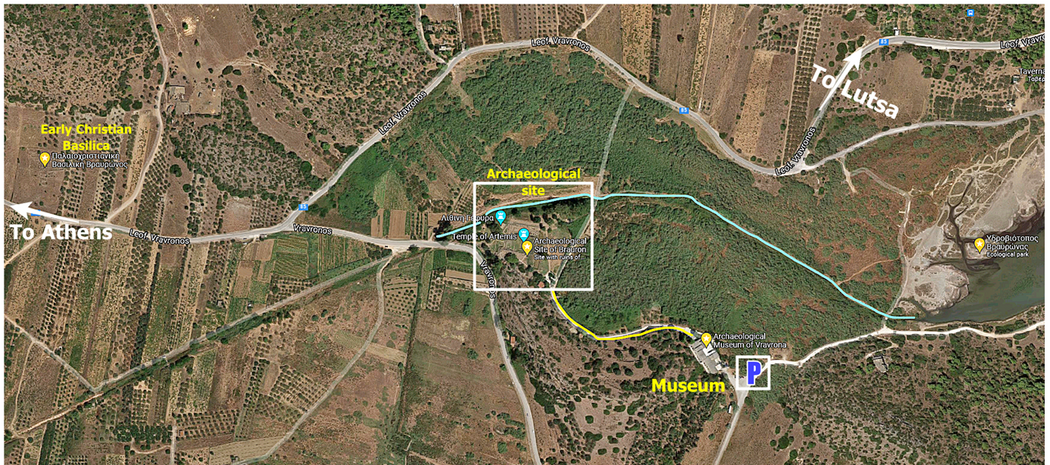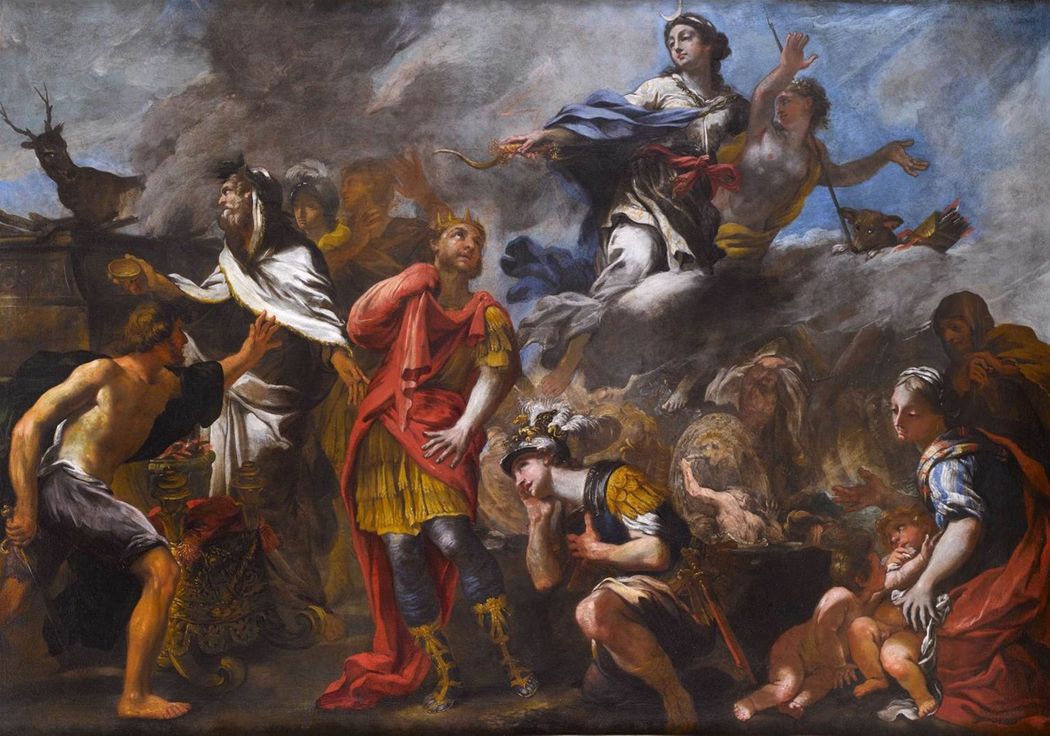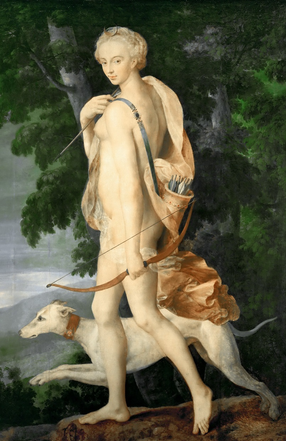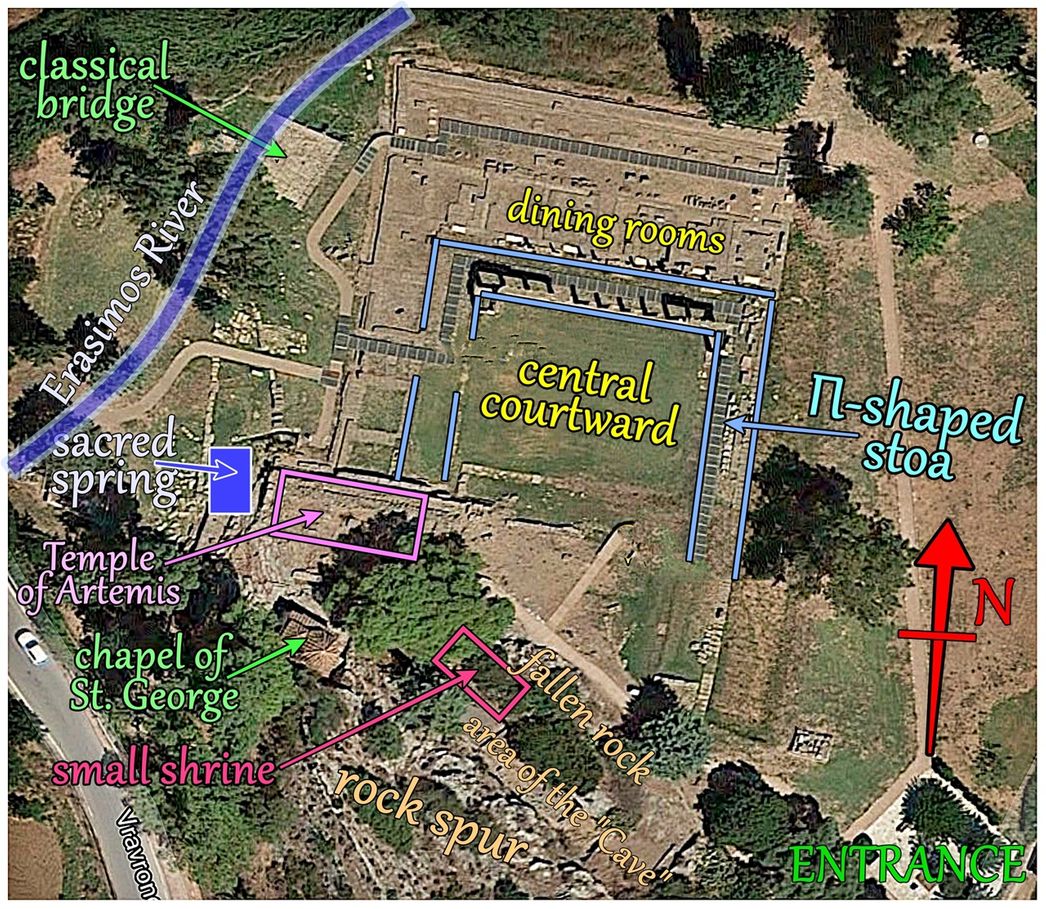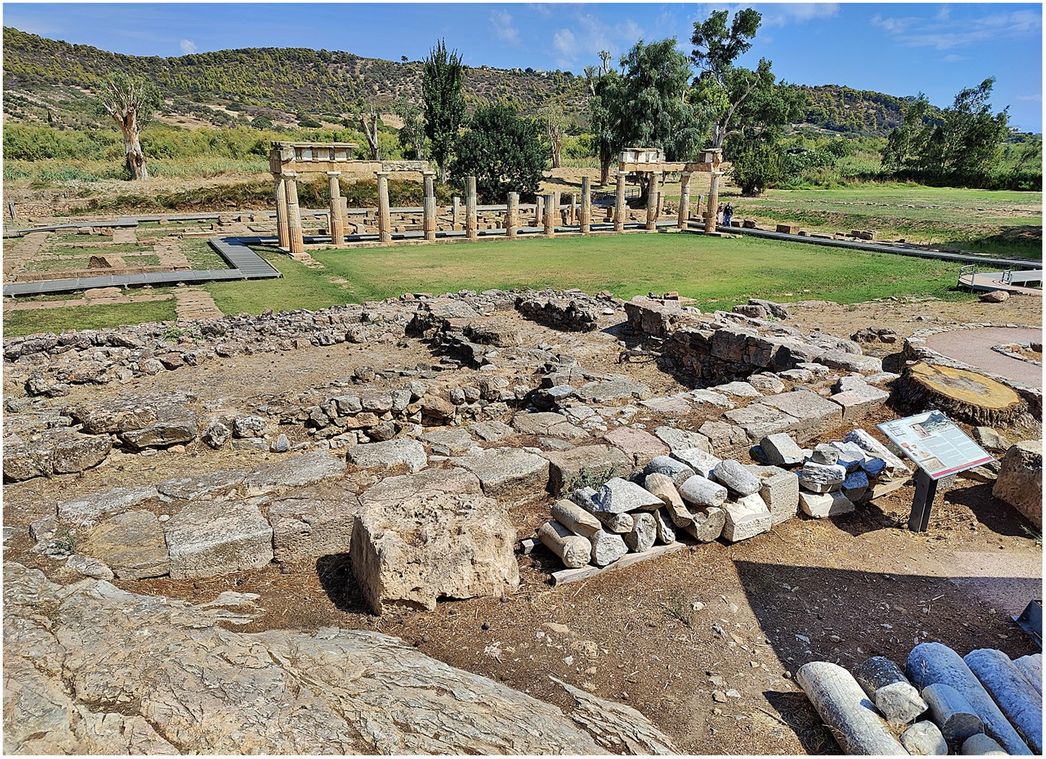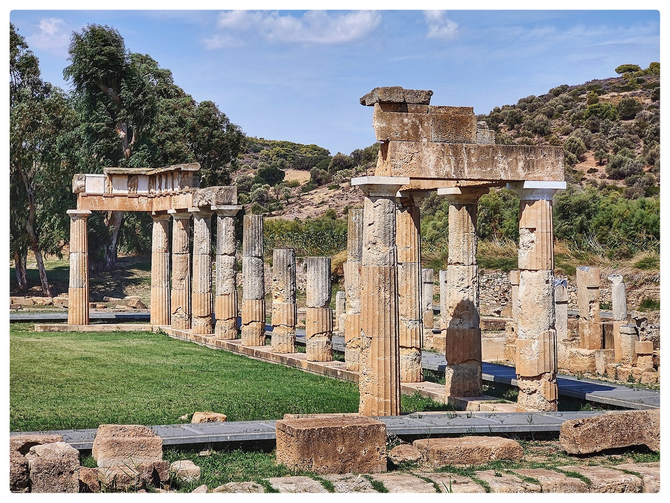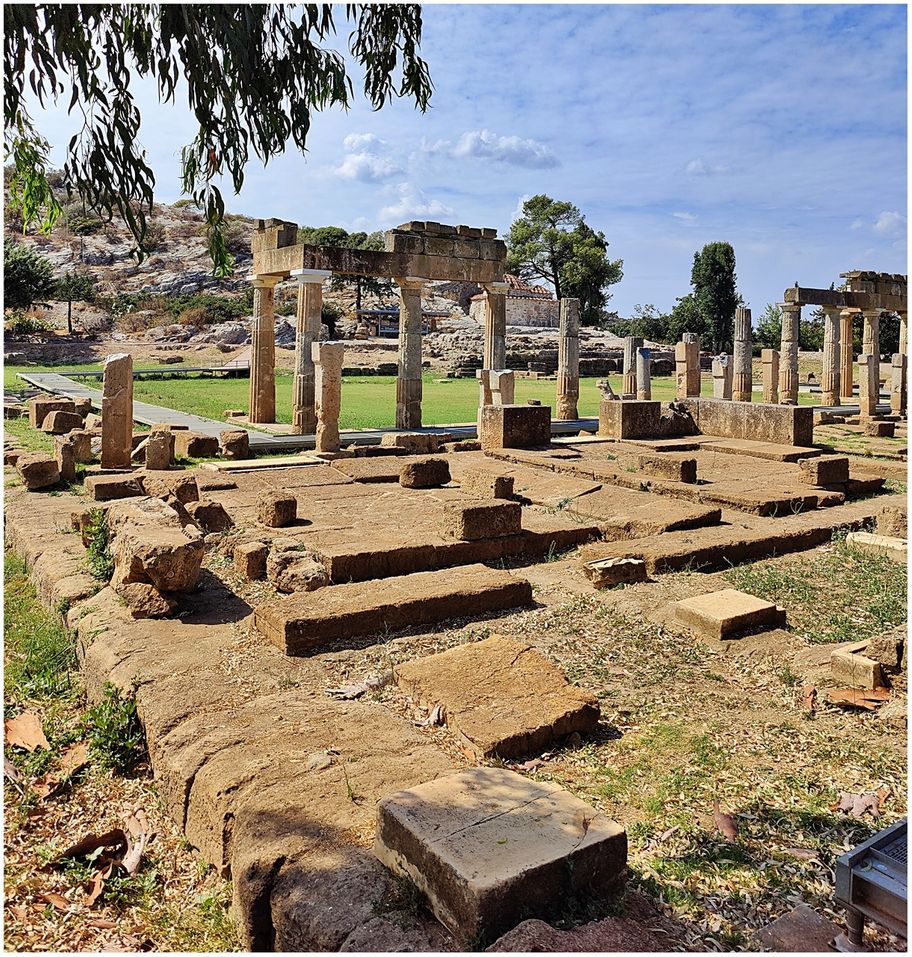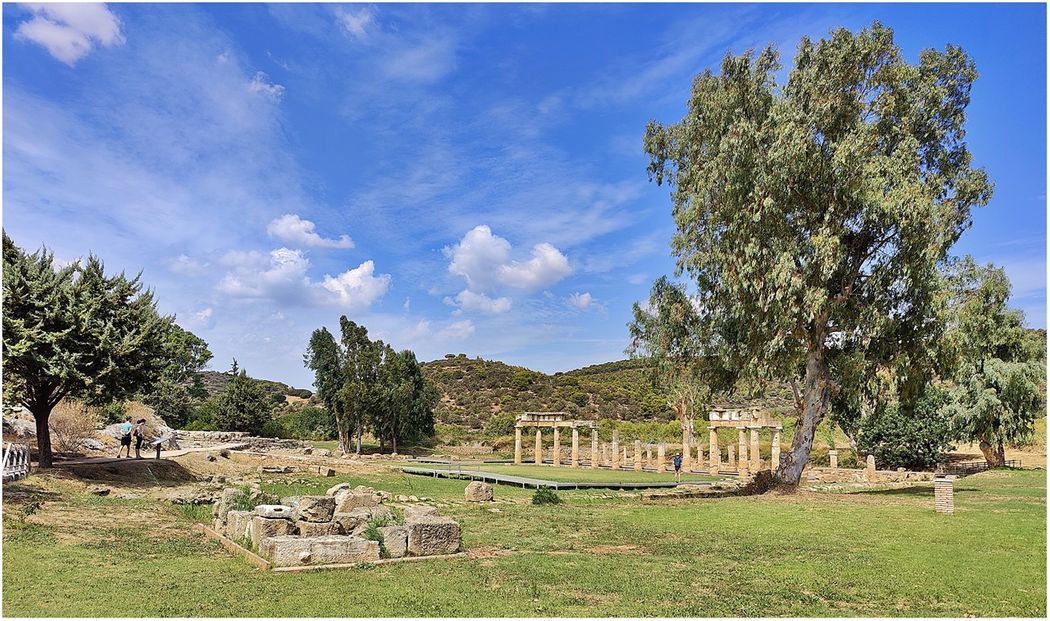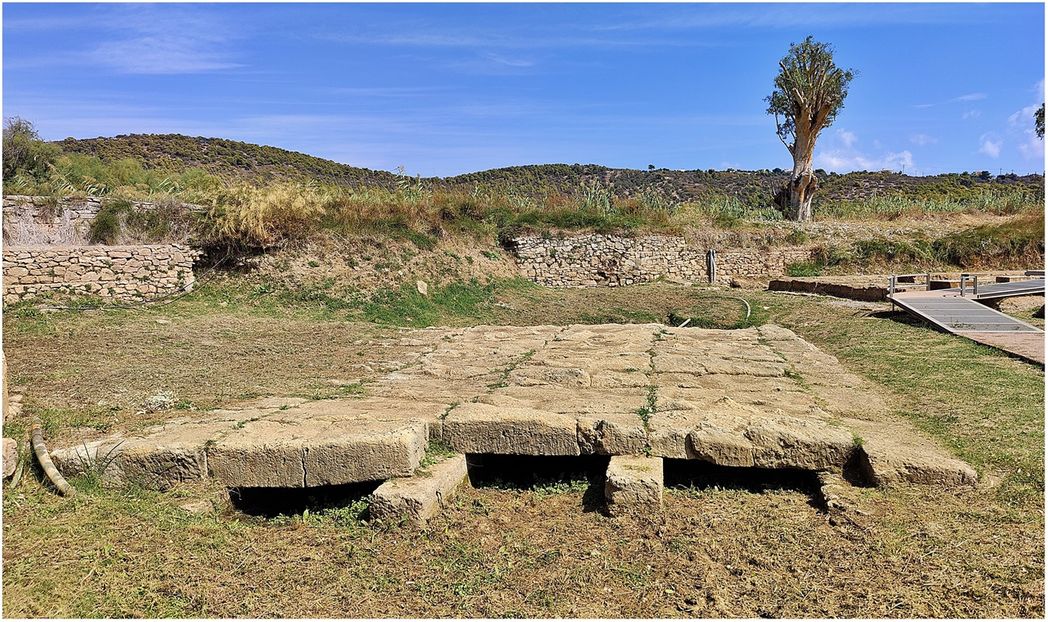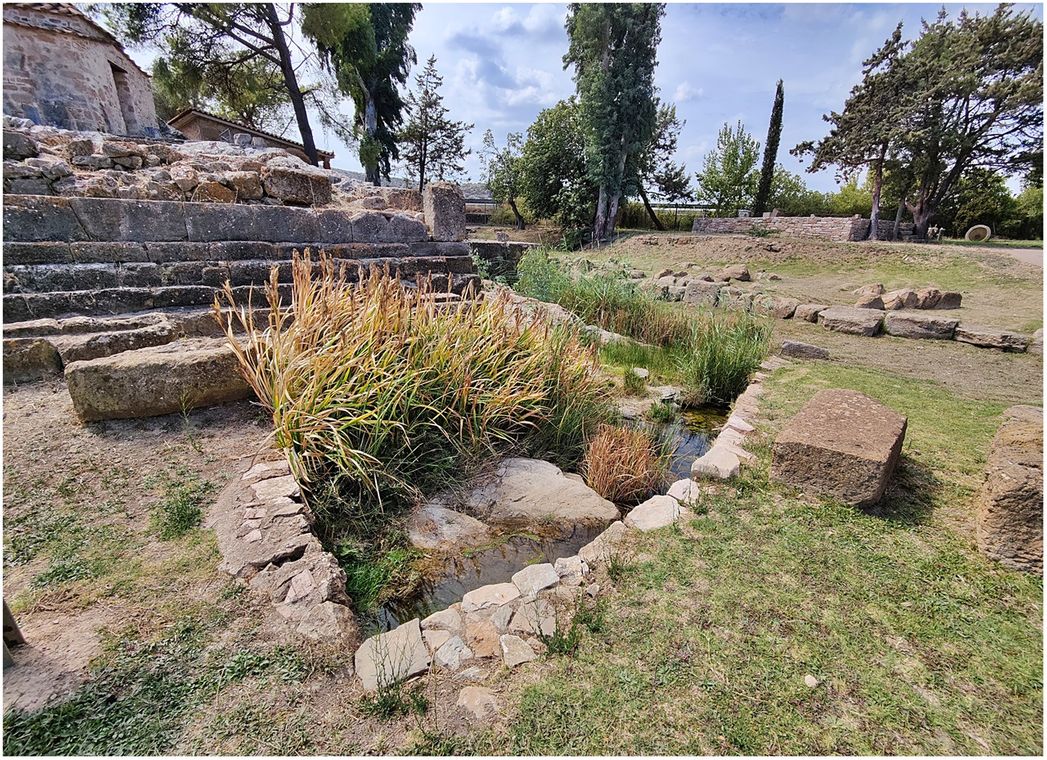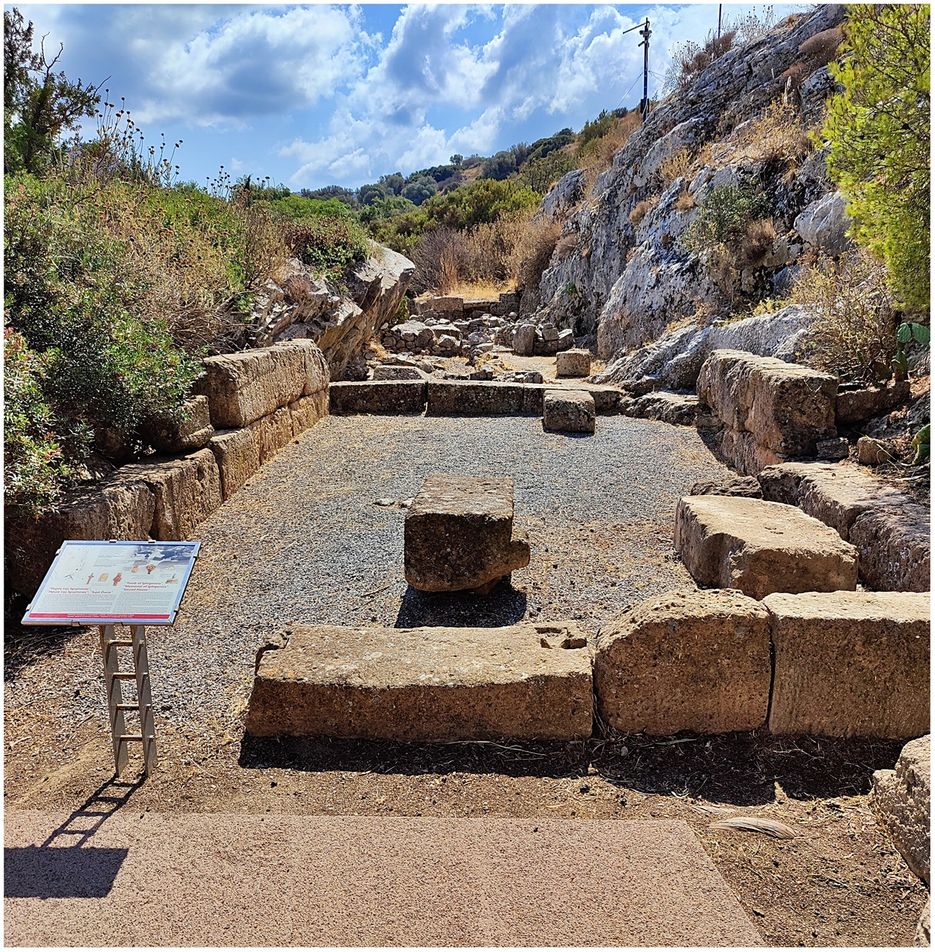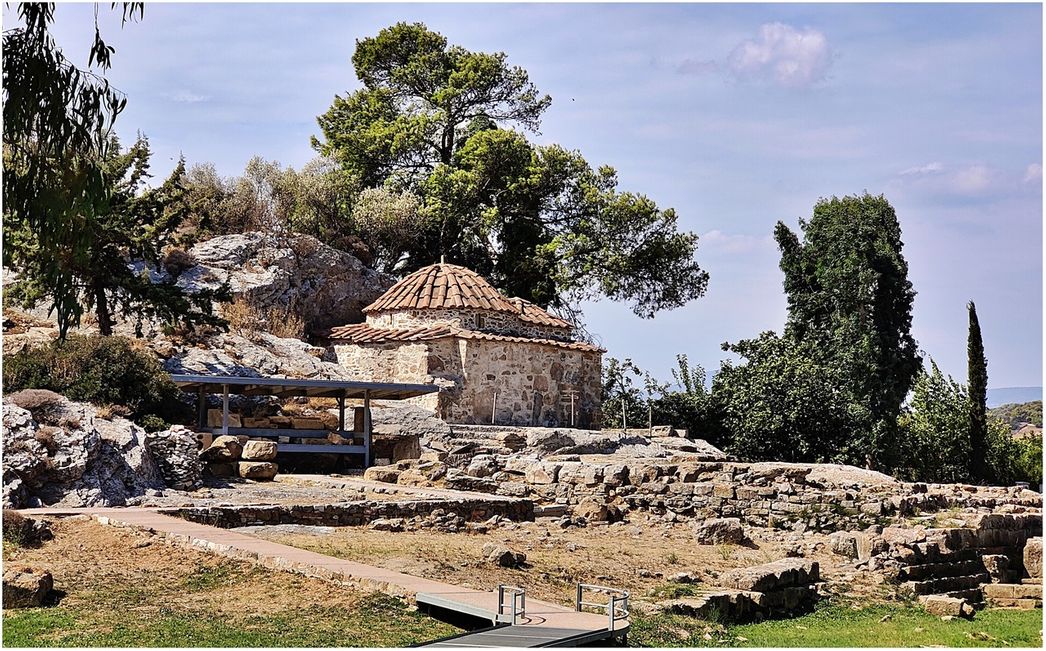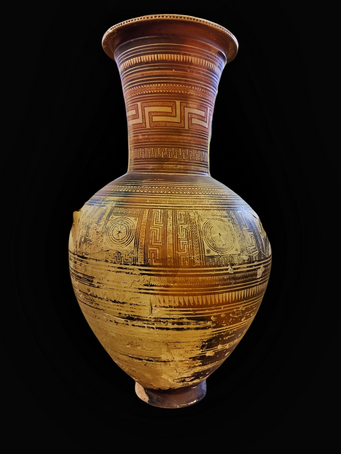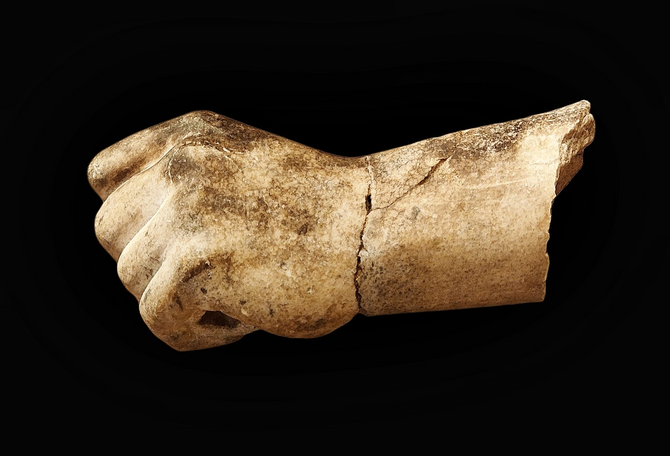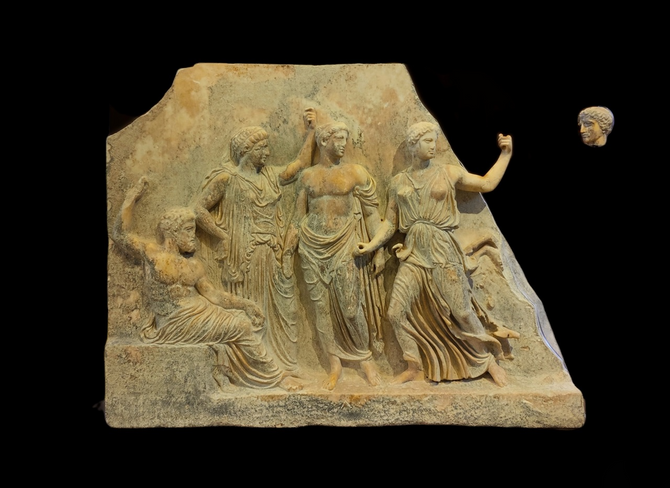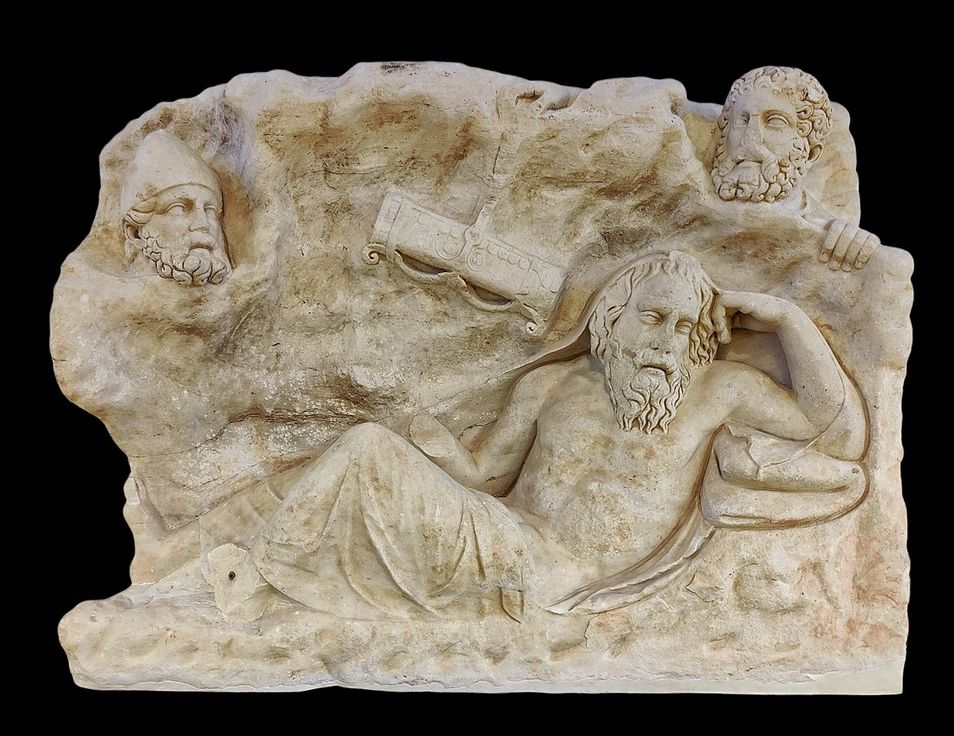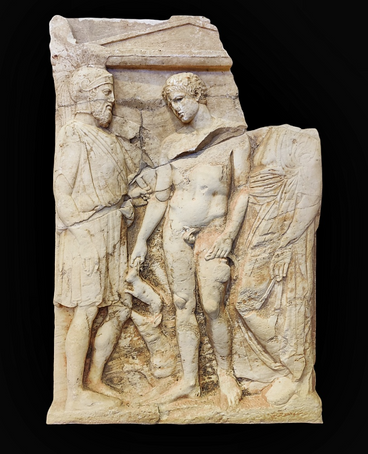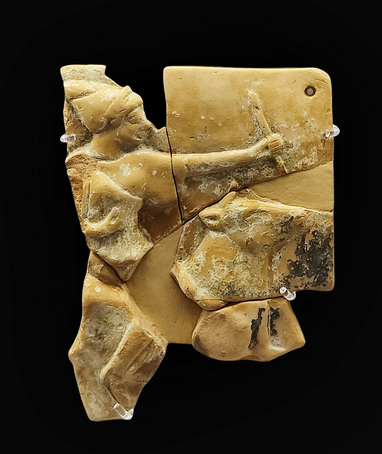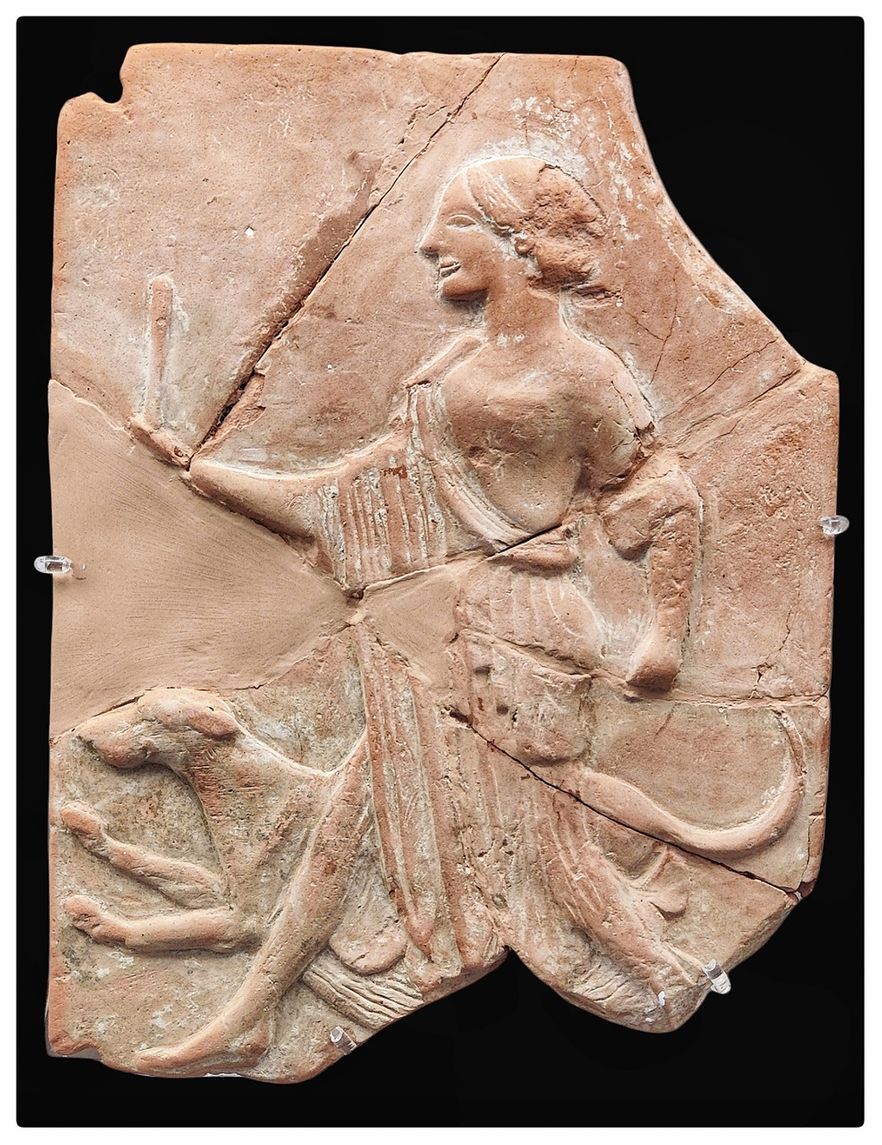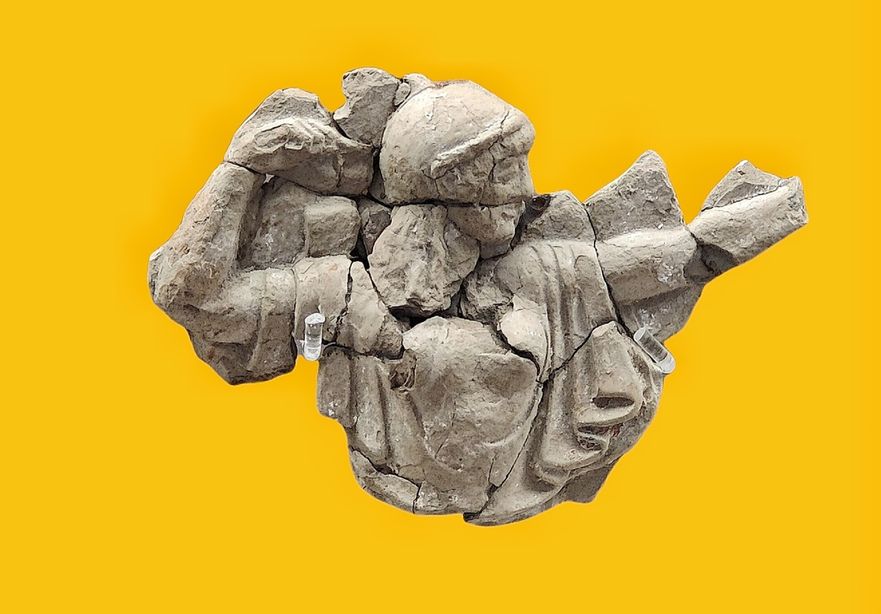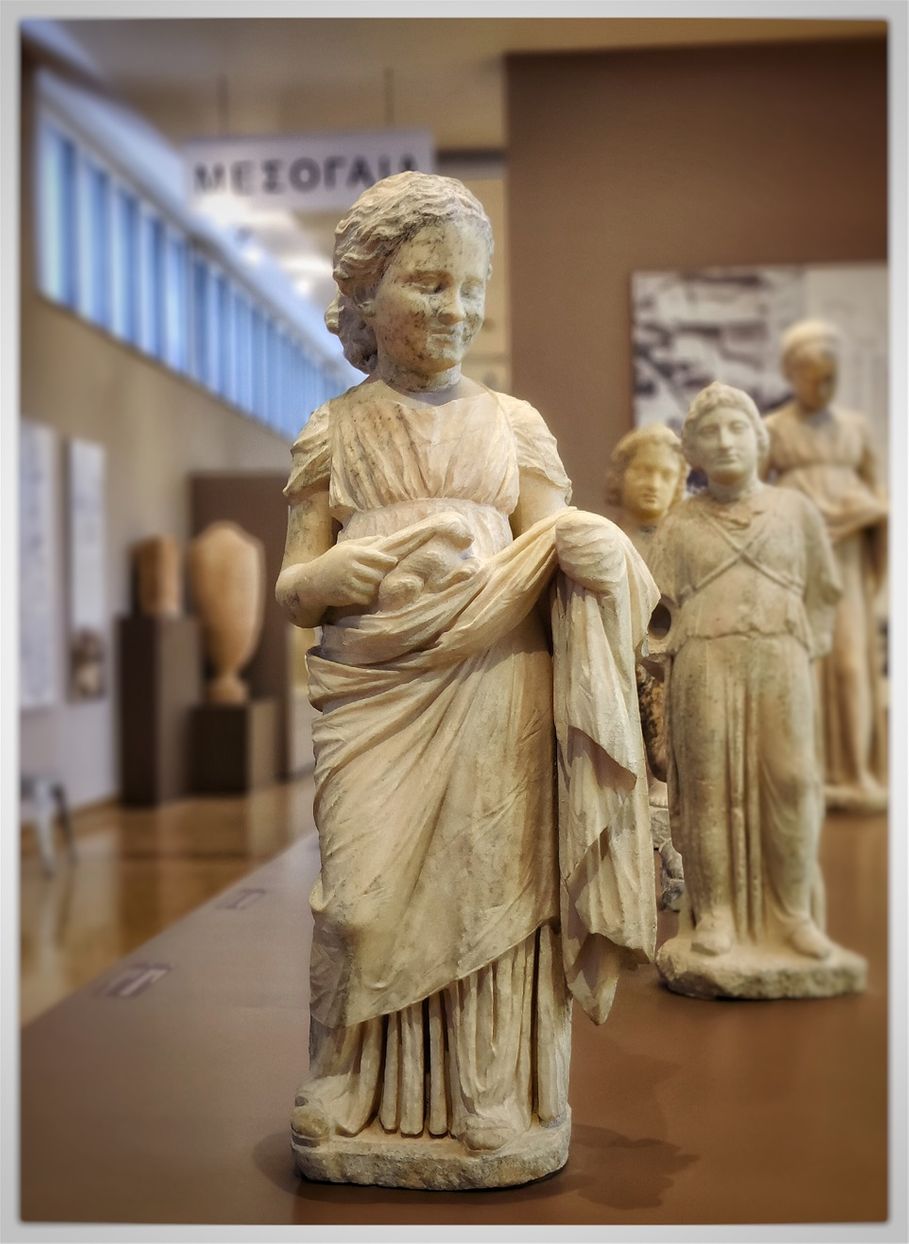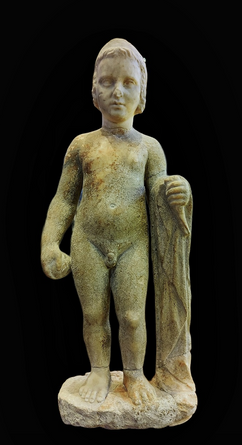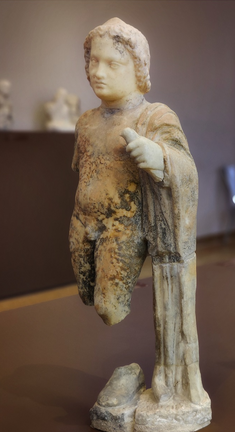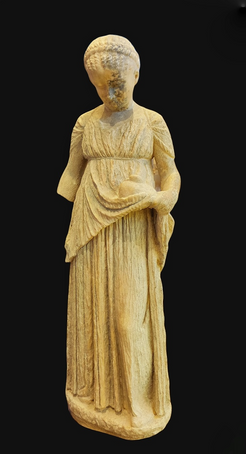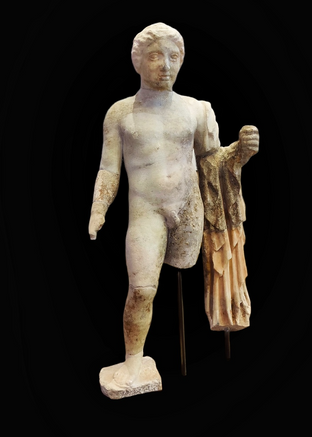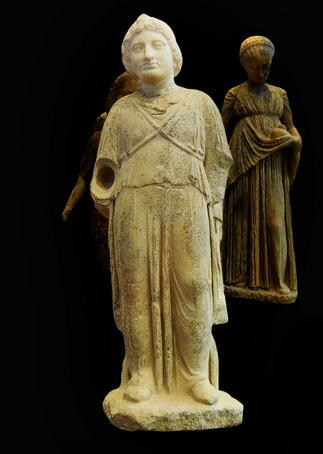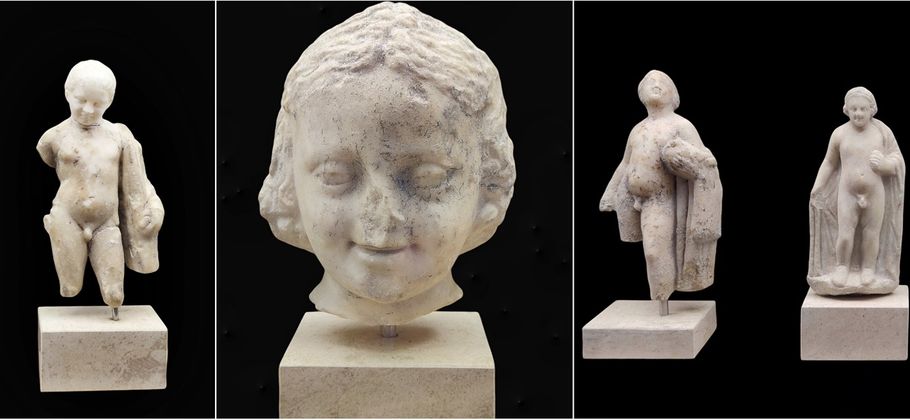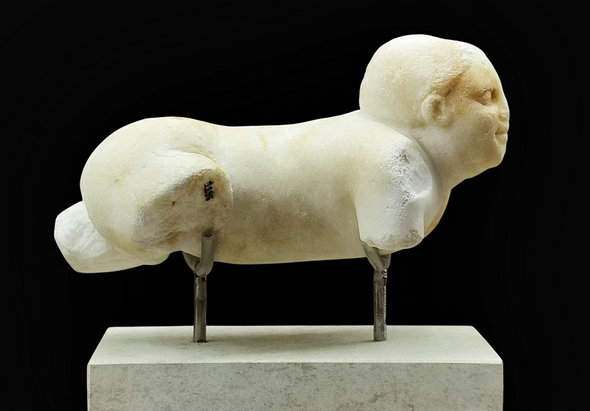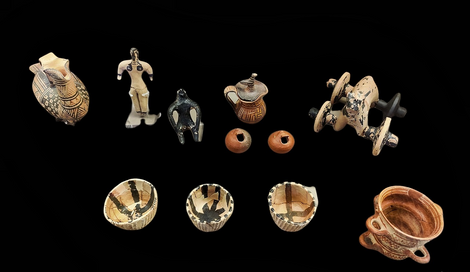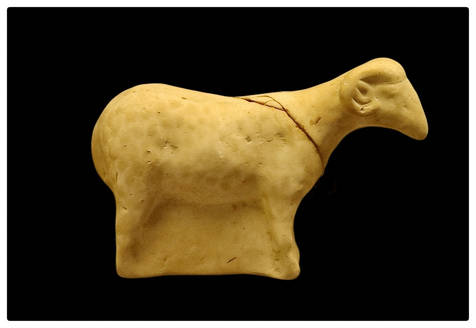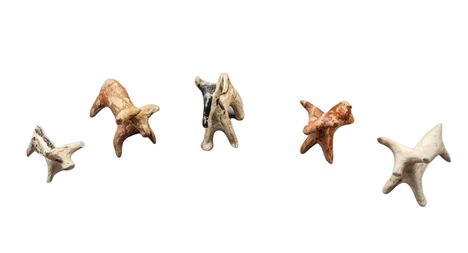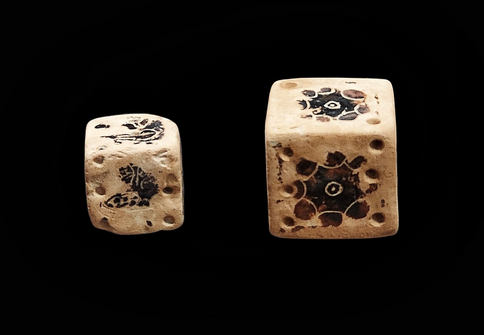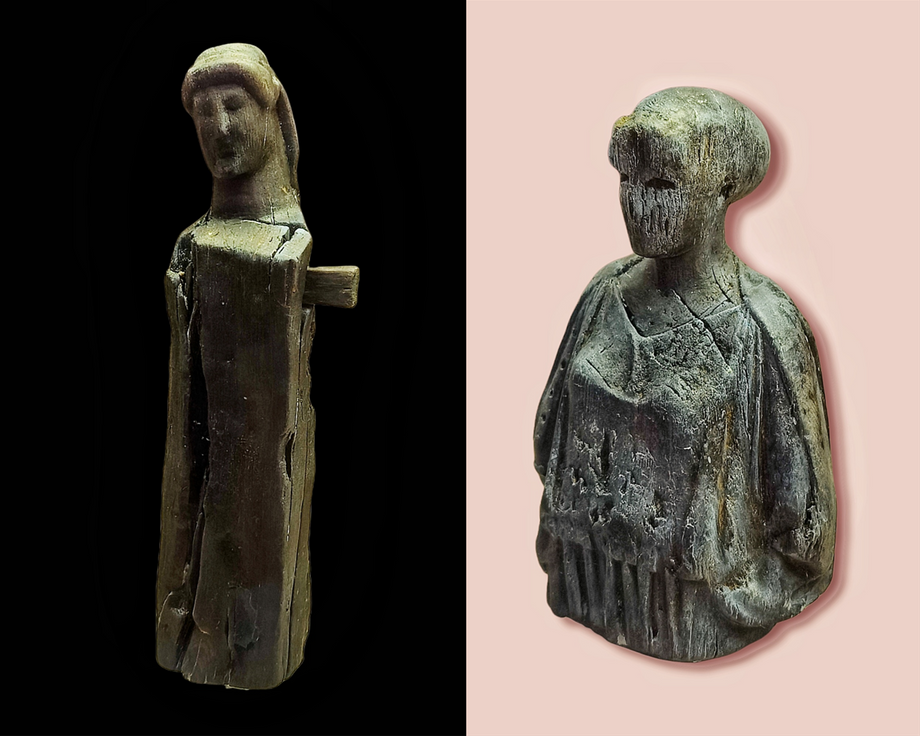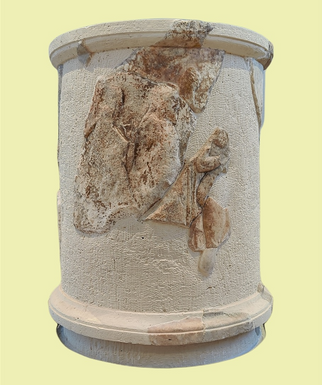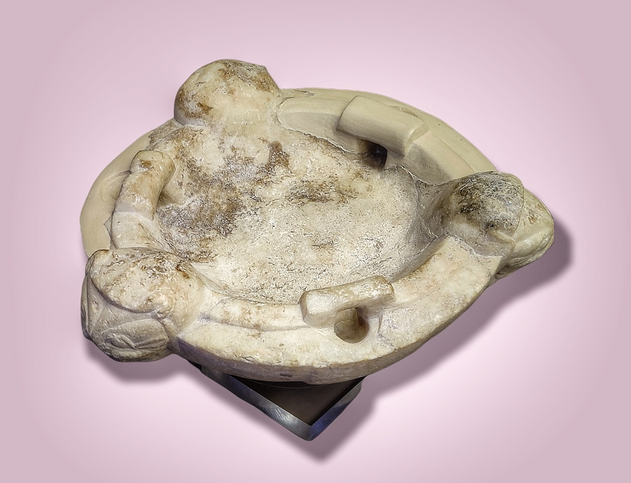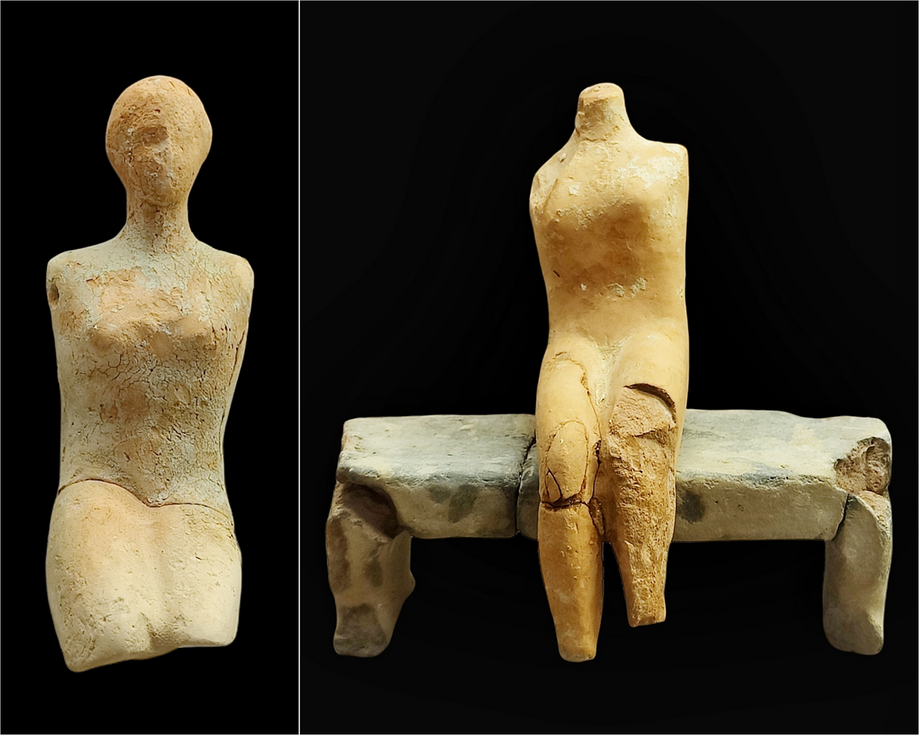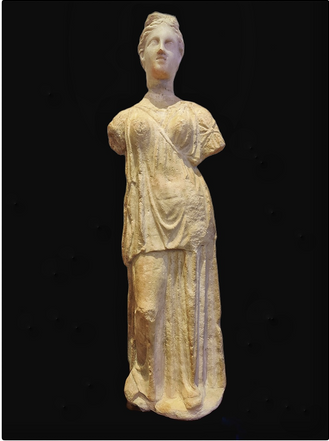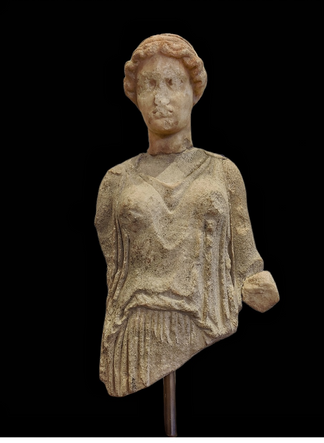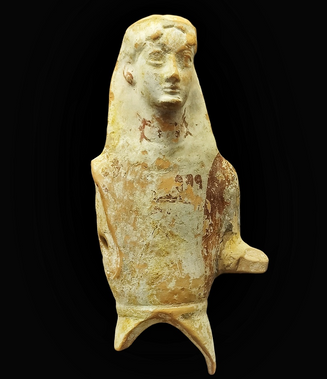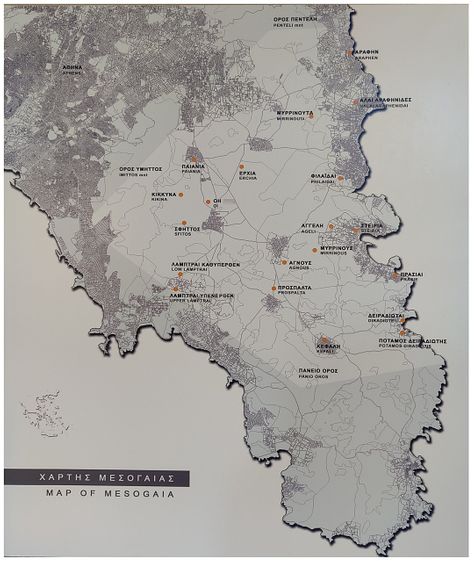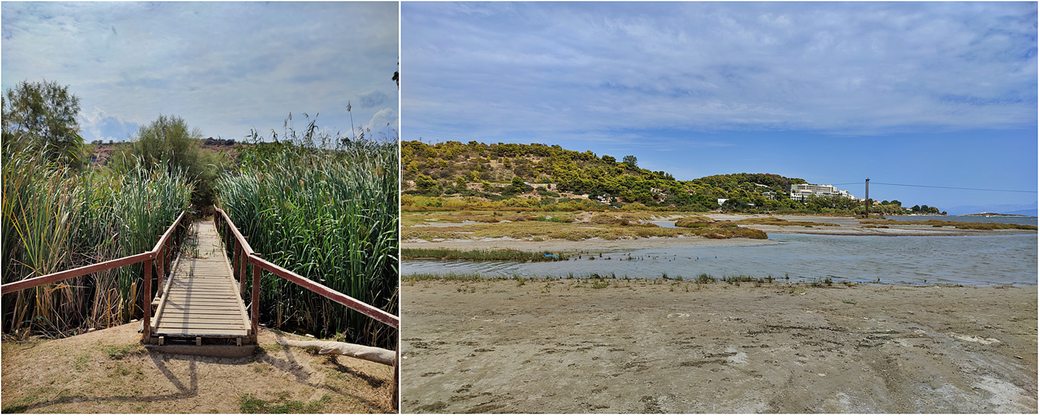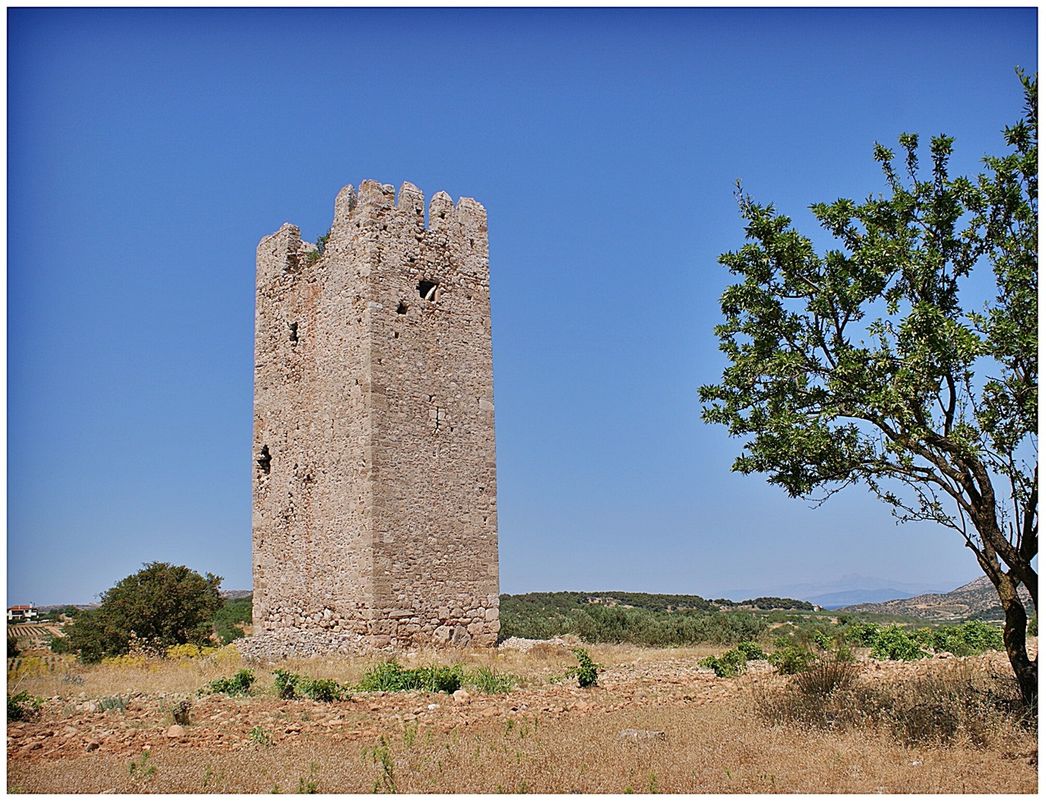The archaeological site of
Vravrona (Βραβρώνα)
October 2021
The archaeological site of Vravrona (Βραβρώνα) Brauron (Βραυρών) is situated on the east coast of Attica, close to the Athens International Airport and 40 km from the center of Athens. It is located in a small valley formed by the river Erasinos. The estuary of Erasinos forms a wetland that hosts a variety of birds. The archaeological site is small but one of the most beautiful in the country. The visit can be short, making it a perfect day trip for Athenians and visitors who have a turnover at the airport. The Archaeological Museum of Brauron — located around a small hill 330 m to the ESE — contains an extensive and essential collection of finds from the site throughout its period of use. It was renovated in 2009, and the exhibits were rearranged.
Map of East Attica, including the Athens International airport and the Vravrona Archaeological Site.
Visitors may buy tickets (valid for both the site and the museum) (Full: €6, Reduced: €3) either in the museum building or at the little kiosk at the archaeological site entrance.
Gary Corby's (an Australian author of historical mysteries set in the world of Classical Greece) mystery novel "The Marathon Conspiracy" is mainly set at the Brauron shrine.
The Archaeological Site of Vravrona and its museum.
History
Vravrona was one of the twelve cities of ancient Attica, which all later unified with Athens. Brauron is celebrated on account of the worship of Artemis Brauronia, whose honor, a festival, was celebrated in this place. The cult of Artemis Brauronia connected the coastal (rural) sanctuary at Brauron with another (urban) sanctuary on the Acropolis in Athens, the Brauroneion, from which there was a procession every four years during the Arkteia festival. The tyrant Pisistratus was Brauronian by birth and is credited with transferring the cult to the Acropolis, thus establishing it statewide rather than locally. The sanctuary contained a small temple of Artemis, a unique stone bridge, cave shrines, a sacred spring, and a Π-shaped stoa that included dining rooms for ritual feasting. The unfortified site continued in use until tensions between the Athenians and the Macedonians in the 3rd century BCE caused it to be abandoned. After that time, no archaeologically significant activity occurred until the erection of a chapel dedicated to Saint George in the 15th century CE. A Christian basilica was built in the 6th century CE on the other side of the Erasimos valley using spoilage from the sanctuary.
Mythology
As the Greek fleet was preparing to sail to Troy to force the return of Helen, they gathered in Aulis near the Euripus Strait. While there, king Agamemnon killed a stag sacred to the goddess Artemis. The enraged deity caused a contrary wind and eventually forced the king to agree to sacrifice his daughter Iphigeneia to ensure a favorable wind for the Greek fleet. In one version of the myth, a surrogate sacrifice was provided through the divine intervention of Artemis. The saved girl became a priestess of the goddess among the Tauri, a people living near the Black Sea in the Crimean Peninsula. After these events, Iphigenia returns from among the Tauri with the assistance of her brother Orestes. In Euripides' version of the myth ("Iphigeneia in Tauris"), the goddess Athena reveals that Iphigenia will make landfall in Brauron, and there, the priestess of Artemis will die and be buried.
In this painting, Giovanni Andrea Carlone captures the point at which Agamemnon had intended to sacrifice his daughter Iphigenia to the goddess Artemis. The goddess obscures the scene with a cloud and snatches her from the sacrificial altar leaving in her place a deer.
ATHENA: And Orestes, learn well my commands – for you hear the voice of the goddess although you are not present – set forth taking the (sacred) image and your sister, and when you reach god-built Athens, there is a place on the outermost borders of Attica, a neighbor of the Karustia ridge, sacred, and my people name it Halai. Build a temple there and set up the wooden image – called for the Tauric land and your struggles, which you endured wandering through Greece due to the goads of the Furies. And in the future, mortals shall sing hymns to the goddess Artemis Tauropolos. And set up this law: whenever the people keep the festival as a payment of your sacrifice, hold a sword at a man's throat and draw blood so that the goddess may have her divine honors by this. And you, Iphigenia, beside the holy stairs of Brauron, you must hold the keys for the goddess herself: where you will die and be buried, and – as a delight for you – they will dedicate the finely woven material of woven cloth which by chance women having lost their lives in childbirth abandon in their homes. I command you to send forth these Greek women from this land for their correct intentions.
Euripides, "Iphigeneia in Tauris" ( Ἰφιγένεια ἐν Ταύροις) 1446–1468.
Cult of Artemis Brauronia
The Arkteia festival was celebrated every four years and involved a procession from the shrine of Artemis Brauronia on the Acropolis of Athens. At the isolated sanctuary of Artemis at Brauron, young Athenian girls approaching marriageable age formed groups consecrated for a time to Artemis as arktoi (άρκτοι-she-bears). They spent their time in sacred dances, wearing honey-colored saffron robes, running races, and making sacrifices. Vase paintings show that cultic nudity was an element in these preparations for womanhood. An epigram in the "Anthologia Graeca" concerns the offerings of childish playthings a nubile young girl dedicates to Artemis on the eve of marriage; many such tokens have been recovered from the spring at Brauron. The goddess Artemis was a danger to be appeased by women during childbirth and of the newborn: to her were dedicated the clothes of women who had successfully borne a child. The garments of women who died in childbirth were dedicated to Iphigeneia at Brauron. There may have been joint worship of Iphegenia associated with a cult site or heroon that may have been located in the "cave" between the face of the rock spur and the fallen rock.
Diana the Huntress, c. 1550, oil on canvas, School of Fontainebleau, 75.25 in x 52 in (191 cm x 132 cm), Musée du Louvre.
The Archaeological Site
The Temple of Artemis
The first known temple at the sanctuary - dating to the late 6th century BCE - rests on a low rock spur south of the river and is aligned toward the east on a foundation measuring c. 11 by 20 m. Little is preserved beyond partial lower courses and cuttings in the bedrock for the same. A few remains of the architecture allow specific identification of the temple as being of the Doric order. The Persians destroyed the sanctuary structures in 480 BCE and returned the cult statue to Susa. The temple was reconstructed in the 420s BCE. Although the temple is poorly preserved, it can be rebuilt to have four columns in the cella (naos) and an adyton (innermost chamber of the temple) at the rear of the cella. The presence of an adyton is asserted for the temple of Artemis at Loutsa (Artemida), 6.1 km to the north, and the temple of Artemis at Aulis, 67 km northwest. The 6th century BCE Temple of Aphaea on Aigina may also share this feature. Most probably, the shared characteristic of an adyton was a typical regional practice in the cult of Artemis. There is disagreement on whether the temple has been hexastyle-prostyle (6 columns across the front only) or distyle in antis (2 columns between projecting walls) in the plan. A stepped retaining wall is on the temple platform's northern side.
The Temple of Artemis (in the foreground).
The Π-shaped stoa
The Doric stoa wrapped around three sides of a central courtyard (20 by 27 m) and faced south toward the temple of Artemis. The foundations extend to the west wing for 38 m, the north wing to 48 m, and the east to 63 m. Only the north colonnade of the stoa (11 columns) and one column of each of the two wings are standing today. Behind the arcade were a passageway containing many votive stelae (some with votive statues of children at the top) and doorways into nine roughly square rooms (c. 5.5 by 5.5 m) on the north and west sides of the structure.
The north colonnade of the Stoa.
These doorways were off-center relative to the rooms, each with raised platforms extending from all sides. Many cuttings (some still containing lead) are on these platforms designed to hold dining couches — eleven for each dining room. Some of the rooms preserve small stone tables situated in front of the location of the couches. These structures are among the most paradigmatic examples of Greek dining rooms known. The walls of these rooms were constructed of a single course of massive limestone ashlar blocks with no cuttings on their upper surfaces. The walls were thus completed in mud brick to the roof level. On the western side of the stoa was an entrance with wheel ruts worn into the stone floor and in line with the Classical bridge.
The dining rooms behind the north arcade (in the foreground).
The stoa was built of local limestone covered in marble stucco, except for the Doric capitals, the metopes, the lintels, and the thresholds produced from marble. This design was a highly atypical feature of using two triglyphs in the inter-columnar interval instead of the typical single triglyph. This was done to lower the total height of the entablature while allowing the metopes to remain square. In addition, the returning angles of the frieze demanded the architectural accommodation of corner expansion (as opposed to the corner contraction seen on many temples) to harmonize the intervals of the triglyphs, which could not be placed dead center over the corner column.
Immediately north of the stoa and sharing a common wall was a structure of unknown function with elaborate entrances on both the west and east sides. Its long axis measured 48m (equivalent to the stoa) and was c. 11 m wide. Along the northern wall of this structure, there was a series of slotted bases for narrow (perhaps wooden) planks; these planks are hypothesized to have held the garments dedicated to Iphegenia, as discussed by Euripides in his drama "Ιφιγένεια ἐν Ταύροις".
The archaeological site (seen from the east).
The Stone Bridge
This stone bridge is the only known example of a Classical period bridge in Greece. It measured c. 9m wide with a span of c. 8m, consisting of four rows of lintel blocks resting on five rows of posts (the two endpoints and three intermediate supports). It uses the standard post and lintel construction of its time rather than arches as later bridges do. Wheel ruts are cut into the bridge's stones at an oblique angle toward a simple entrance on the west side of the stoa; these cuttings do not go toward the elaborate propylon (monumental entranceway) of the structure north of the stoa as might seem more likely.
The stone bridge
The Sacred spring
A spring emerged from the northwest end of the rock spur running down from the acropolis hill to the site's southeast. This spring was the focus of cult activity from the 8th century BCE forward. Dedications were made by throwing objects into this sacred spring immediately northwest of the later temple platform. The first activity in the area known after the Bronze Age is thus linked to cultic practice to this spring.
The Sacred Spring.
The Small shrine
About 12m southeast of the Temple of Artemis, a small shrine (Μικρόν ιερόν) 5.5 by 8 m was built into the space between the face of the rock spur and a mass of fallen rock measuring 25 m in length. The 6 m vast space between the front of the rock spur and the fallen rock is densely packed with structural remains of uncertain function. This area has been associated with the propitiation of Iphigenia, perhaps as a heroon. Some of these structures were probably in place before the rockfall. It is possible that the small shrine replaced a cult site (perhaps for Iphigenia) destroyed by the collapse of the rock overhang under which it was built. The area between the face of the rock spur and the fallen rock has been termed a “cave” in some publications. There is another cave higher on the rock, approximately over the entrance to the archaeological site. This was converted into a makeshift chapel of St. George.
The Small shrine.
The chapel of Agios Georgios.
The chapel of Agios Georgios (St. George) is located just south of the temple of Artemis on the ruins of an earlier, more prominent Christian temple. It is built northwest of the sacred rock, and a part is carved into it. It is a one-room church of the late Byzantine period (probably of the 16th century). Its roof is made of tiles, and the entire small church is made of materials from the early Christian years. Its octagonal dome rests on blind arches and forms the most significant part of the temple. A "blind" and irregular sanctuary niche is on the east side, reaching the tiles. To the west is a vaulted narthex with a raised tiled roof, which, together with the dome, creates a pair of high ends. The church is closed to the public.
The chapel of Agios Georgios.
The Archaeological Museum
The Archaeological Museum of Vravrona has presented the history of the excavations in the sanctuary of Artemis in Vravrona (1948–1963) and the works for the restoration of the Stoa, the largest and best-preserved building that came to light.
Room 1
In Room 1 are displayed the settlements, which were organized in the broader area of Vravrona from prehistoric times until the formation of the ancient municipality of Philaides (Δήμος Φιλαϊδών), whose religious center was the sanctuary of Artemis. The settlements in Pousi-Kalogeri (Πούσι-Καλογέρι), Pyrgos (Πύργος Βραυρώνας), the coastal hill of Vravrona and the Mycenaean cemetery on Lapoutsi (Λαπούτσι) will give a complete picture of the prehistoric era from the end of the Neolithic Age to the Late Bronze Age. From the municipality of Philaides are exhibited findings from the small archaic sanctuary on the hill of Agios Dimitrios and the cemeteries of Kapsala and Karabamba (Καψάλα & Καράμπαμπα). In the same room are presented the monuments of the sanctuary of Vravrona. Finds are also exhibited from monuments of the wider area, the early Christian basilica, the medieval Tower of Vravrona, and the neighboring sanctuaries of the ancient municipality of Alon Arafinides (Temple of Artemis Tavropolos and a small beach sanctuary in Artemida).
Belly-handled amphora. Anavyssos, 8th century B.C.
At the Brauron sanctuary, there were six cult statues. Recently, parts of four acrolithic 5th and 4th century BC statues were identified. This arm is part of one of those statues.
Room 2
In Room 2 are displayed findings on the founding of the sanctuary of Artemis, the worship services in honor of the goddess, and the qualities with which Artemis is projected in Vravrona. The most important exhibits are The marble "Relief of the Gods" (which depicts the myth of the foundation of the sanctuary), votive reliefs of the 5th and 4th BC. with processions of families preparing to make a sacrifice, marble edges from worship statues of Artemis (which according to the inscriptions wear real clothes); and tiny craters (ritual vessels associated with the worship of Artemis). Also displayed are clay votive tablets, clay figurines, and vases depicting Artemis with her various qualities as Artemis-Hecate, Tauropolos (riding a Bull), Hunter, and a Protector of Animals.
The scene's subject on the relief of the Gods is Iphigeneia's arrival at Brauron and the establishment of the sanctuary according to the tradition mentioned by Pausanias. The first figure on the left is a bearded man, possibly Zeus, seated on a low rock and holding a cane or a mace with his right hand, which was painted. A mature female figure, Leto, follows. She wears a peplos covering part of her head and holds a painted mace. Apollo is standing next to her, possibly with a laurel branch. He, just like Zeus and Leto, is facing right. The female figure wearing the attic peplos is Artemis. She is running to the left but facing right like the other figures. The holes in her tight fists imply she was holding bronze objects, possibly a torch and a bow. In the right part of the scene, which is missing, the two siblings, Orestes and Iphigeneia, were possibly depicted on a chariot drawn by two deer. Orestes had just pulled the harness of the chariot, and the deer sat up on their back feet while Iphigeneia stood holding the goddess's puppet. The head at the right of the remaining relief is identified with Iphigeneia. According to other interpretations, Artemis arrives at Brauron with a chariot drawn by deer while the figure wearing a peplos is identified with Iphigeneia, who either holds two torches or the reins of the chariot. The male figure at the beginning of the scene has also been attributed to Brauron, the eponymous hero of Brauron.
Before the middle of the 2nd century, A.D. Marble slab found in Merenda depicts the myth of stealing the weapons owned by the Homeric hero Philoctetes, who had resorted to Lemnos, according to the version of the tragic poet Euripides. Rather old and ill, Philoctetes is bent in a cave. In the background, behind the cave's entrance, two male heads are visible. The first one, with a thick beard and a conical hat, is identified with Odysseus. The other one, probably Diomedes, with thick hair styled in locks and a beard, dispossesses Philoctetes of his bow and quiver.
GRAVE STELE. Pentelic marble. Porto Rafti (Drivlia). 410-400 B.C. Attic grave stele surmounted by a relief pediment supported by pilasters. The names Kloeboulos and Menon are incised on the pediment. There are three figures depicted in the scene. The beardless young man in the middle is depicted as a palaestretes (an athlete) holding a strigil and an aryballos. He is accompanied by his dog, while the other hand, he is a small rabbit. The figure standing on the youth's right is a bearded warrior with an attic helmet on his head, a shield and a spear in his left hand, and a sword hanging from the telamon. Kleobolos and Menon are the youth's and the warrior's names, respectively. On the youth's left stands an older man, possibly Kleoboulos' father, wearing a himation. The stele is attractive in architectural form, composition, and iconography. Both young Kleoboulos, the central figure of the scene, and the bearded Menon, with his entire warlike appearance, are dead. Menon could be identified with Menon the trierarchos (official of the Athenian Navy), whose name is to be found in a casualty list dated by the end of the Peloponnesian War. The death of young Kleoboulos was the reason for the erection of the stele on which his relative Menon, already killed in the battle, was also depicted. The lower part of the stele was found in 1961/2 at Drivlia, Porto Rafti, and in 1963 it was handed over to the museum of Brauron. The upper part of the stele was smuggled and sent abroad. In 1990 it was published in the catalog of the Shelby White and Leon Levy Collection of the Metropolitan Museum of Art in New York and became widely known. After its identification by professor Georgios Despinis, the repatriation procedure began, and it was completed on August 1st, 2008.
ARTEMIS TAUROPOLOS Artemis received offerings as "Tauropolos" at the sanctuary of Brauron, a quality with which she was mainly worshipped at the neighboring sanctuary of Halai Araphenidai. The name "Tauropolos" is a complex word: bull (ταύρος) + πόλος (πολέω = hover, hang around). The depiction of a female goddess that rides a bull was already known from the Bronze Age. The relationship of Artemis with the bull derives mainly from her quality as a goddess of wild nature and fertility. The domestic cattle, as depicted in the large marble reliefs of Brauron, were offered and sacrificed in honor of the goddess as a unique animal sacrifice. They are not connected with Tauropolos Artemis.
Artemis hunting with her dog.
Artemis hunting with a bow.
Room 3
In Room 3 are displayed the numerous statues of little boys and girls, as Artemis was the patron goddess of childbirth and children. The parents dedicated the statuettes to please or ask the goddess to protect their children. The toys (fish vertebrae, ankles, dice, small vessels, planks) were children's tributes to the goddess.
Maiden goddess Artemis protected newborns and young women during labor, the most crucial moment of their life. According to the myth, when Artemis was young, she assisted her mother, Leto, as she leaned against the trunk of a palm tree to deliver her twin brother Apollo.
The numerous statuettes of young boys and girls that were found at the sanctuary (dating to the second half of the 4th century B.C.) indicate that during this period, Artemis mainly appeared as the goddess of labor and child protector, which is why she is called Locheia and quite often she is identified with Eileithyia, the goddess of confinement. Parents dedicated statuettes of young children probably as thank-offerings for successful childbirth or children's recovery from an illness. This dedication aimed to set their children under the constant supervision and protection of the goddess. Apart from their garments, women also dedicated their children's garments to Artemis.
Besides a religious center, the sanctuary was also a place of education. During this period, the children that served the goddess were trained to contribute to the well-being of society as active citizens. They wear their everyday clothes, a chiton or a himation and hold an animal, a bird or an object, possibly one of their favorite toys, in their hands.
End of 4th century B.C. (around 320 B.C.) Marble statue of a girl. She is wearing a long pleated chiton, girded high under her breast, and himation, which is held in place by the left hand. She smiles innocently and holds a hare at the 'nest' formed by the himation.
End of 4th century B.C. Marble statue of a nude boy. His himation is over his bent left arm. He holds a bird and a ball. He has a wreath on his hair.
Statuette of a young boy.
Statuette of a young girl holding a dove.
Statuette of a teenage boy.
Statuettes of boys and girls as offerings to Goddess Artemis.
Statuettes of boys and girls as offerings to Goddess Artemis.
Statuette of an infant as an offering to Goddess Artemis.
PLAYING IN ANTIQUITY. Playing has been an essential aspect of a child's daily life since ancient times. When children grew, they dedicated their toys to the goddess as a gift for her protection and to define their transition to adulthood. Most toys were made of perishable materials, like fabric and wood, so they have not been preserved till nowadays.
The first toy of a child was the rattle. The most popular games were the ones with astragali (knucklebones), known as 'artiazein' (modern odds and evens), the 'pentelitha' (jacks), and 'astragalismos' (dices). The taws are globules of clay and glass; the dice, the spinning top, and tiny vessels (copies of large utilitarian ones) were included in their toys. The sphere was a ball of leather or fabric stuffed with horse hairs, sand, and hay. Other group games were the standing-still game, hide-and-seek, hopscotch, and the blindman's buff.
Child toys made of clay.
Sheep toy made of clay.
Child toys made of clay.
Dices made of clay.
Room 4
Room 4 presents tributes/personal items from women to the goddess on the occasion of their marriage or the birth of their children: caskets for storing cosmetics and jewelry, perfume containers, jewelry, and bronze mirrors. Artifacts related to the quality of Artemis as the patron saint of handicrafts and weaving and as the protector of women, marriage, and family life, are also shown.
A WOMAN'S WORLD, A significant number of useful female objects, such as pyxis, perfume vessels, and jewelry, are offerings from women to their protector goddess Artemis Brauronia. Women took special care of their appearance by wearing jewelry and using perfumes and cosmetics manufactured from plants and mineral pigments. A woman's world in antiquity was utterly different from a man's. They received a limited education and spent most of their time at home in the women's quarters (oikoi). They were responsible for the regular function of their house and had several duties - the household, children's upbringing, and enslaved people's supervision. Although deprived of political rights, women assumed several prescribed cultic roles in the civic and private sectors. Their social identity was closely linked to various religious functions that affected all aspects of life (marriage, birth, childhood, and death).
THE TANAGRA FIGURINES During the 4th century B.C., the terracotta female figurines usually depict statue types showing the significant fluence of giant sculpture. The majority of the female figurines of this period from the sanctuary belong to the type of so-called 'Tanagra' figurines. The figures wear multi-folded chiton and himation tightly wrapped around the body. They were coated with a liquid white slip and were richly decorated. The arrangement of their body axis varies greatly, and their hair is usually drawn back in a chignon. They are dated from the 2nd half of the 4th century B.C. until the end of the 3rd century B.C.
The unique wooden votive offerings from the Sanctuary of Vravrona have a special place: figurines, vases, and pieces of furniture.
In the center of the same room dominates the large marble cylindrical altar (end of the 4th c. BC), which depicts the reception of Dionysus as a guest god in the sanctuary of Brauronia Artemis.
The penultimate showcase of room 4 includes paintings, banquet vessels (jugs, craters, goblets), and lamps, most of which were used to light the sanctuary. In contrast, others were probably offered as votive offerings. The last section of room 4 includes many female figurines dedicated to the goddess: archaic planks, "tanagreias", and anthropomorphic clay vessels.
WOODEN OFFERINGS One of the most important groups of ancient wooden objects in Greece, which includes figurines, vessels, shafts and parts of furniture dressing, toilet objects, and paintings, was found at the sanctuary of Artemis Brauronia. Ground conditions favored excellent preservation of the objects, most of which were found with clay, golden, metallic, and marble offerings of the 6th and the beginnings of the 5th century B.C. On inscriptions saved from the sanctuary, there is a reference to wooden boxes where women's garments dedicated to Artemis were placed.
The big cylindrical altar found at the Brauron sanctuary was restored in 1967 from 28 pieces from different parts of the archaeological site. The fragmentary scene on the altar consisted of 15 relief figures arranged in order, while above each figure's head was an inscription with its name. According to an interpretive approach, the scene's theme is the welcoming reception of Dionysus as a guest deity to the sanctuary of Artemis Brauronia. Hermes led the procession, and the following figures are identified with Dionysus, the three Horae with Eirene first in order, the three Graces, a Silenus figure, and the three Nymphs - the last of which is depicted seated - Apollo, Leto, and Artemis. The altar is dated around 400 B.C., the period right after the end of the Peloponnesian War when peace was re-established in Attica. This may have been why the artist placed Eirene right after Dionysus, who led the procession toward the temple of Artemis and Hermes. A different approach is identified in the scene's first part, which takes place at the sanctuary of Delphi, Leto, Artemis, Apollo, and Pythia, seated next to him on the Omphalos. In the next scene, a procession begins with Hermes and Dionysus in charge, followed by the goddess Eirene and more groups of secondary female deities participating. A male deity is discerned among them and could be interpreted as "Agon, " related to Eirene's cult.
OIL LAMP. Oil lamps were mainly used for the lighting of private and public buildings and of cult places as well. They were used as offerings at temples and frequently encountered as grave goods in burials. They appear in different variations concerning, especially the shape of the nozzle for the reception of the tow and the addition or lack of a handle. Depending on their way of manufacture, lamps are classified as handmade, wheel-made, or mold-made. They were made mainly of clay – however, stone or metal lamps have also been found. The most basic centers of lamp production were Athens and Corinth, while in post-Christian periods, the so-called Minor Asian and North-African lamps appeared.
PLAGONS (DOLLS) Plagons were typical offerings at Artemis' sanctuaries. At Brauron's sanctuary were male and female dolls made of clay or marble, dressed or naked, with stable or fidgeting members, while most had no hands and limbs. There were possibly dolls made of fabric and wood. Girls offered their toys to the patron goddesses of marriage before their coming of age or marriage. Significant evidence provides an epigram of The Palatine Anthology; Timareta dedicates her dolls and dresses to Artemis before her wedding. "Her tambourines and pretty ball, and the net that confined her hair, And her dolls and dolls' dresses, Timareta dedicate before her marriage to Artemis of Limnae, a maiden to a maiden, as is fit; Do thou, daughter of Leto, laying thine hand over the girl Timareta, preserve her purely in her purity".
Marble statuette of Artemis. End of 4th century B.C. She is wearing a chiton with short sleeves and a peplos with a long ungirded 'apoptygma' (overfold). The telamon of her pharetra is placed obliquely on her chest. Her hair is elaborately tied at the upper part of her head.
Marble female statuette, presumably Artemis. She is wearing a girded peplos forming an 'apoptygma' (overfold). Her hair is elaborately styled—end of 5th century B.C.
THE KORE OF BRAURON One of the most impressive finds of the sanctuary of Brauron is the 'Kore of Brauron'. It is made of clay and is dated to the first half of the 6th century B.C. Although the lower part of its torso is missing, its size corresponds to the marble statues of the same period. The Kore was upright with its hands protuberant and its palm clenched into a fist bearing an open hole where an object would probably be fixed. Similar clay figurines have been found at other sanctuaries (Thassos, Acropolis, Sanctuary of Nymphe, Sanctuary of Artemis Mouni chia). The worshiping substance of the 'Kore of Brauron' is unclear; however, the sanctuaries, where the presence of this type of clay statue has been confirmed, are considered female sanctuaries and are related to fertility and reproduction.
Room 5
Room 5 is dedicated to the history of the ancient municipalities and regions of the area (Μεσογαία): tombstones and finds from Paiania (Παιανία), antiquities of prehistoric and historical times from the area of Koropi (Κορωπί) and the ancient municipalities of Lamptres (Λάμπτρες) and Ois (Όη), representative exhibits from ancient Myrrinountas (Μυρρινούντας, today's Merenda Markopoulou), from the late Mycenaean cemetery of Perati (Περατή) in Porto Rafti (Πόρτο Ραφτη) and the geometric cemetery of Ag. Panteleimon of Anavyssos (Ανάβυσσος).
Mesogaia or Mesogeia (Μεσόγεια) is the eastern part of Attica, watered by the Euboean gulf and surrounded by the mounts Penteli, Hymettus, and Paneion. The fertile valley of Mesogeia has been defined since the Neolithic Period (6th millennium B.C.), the character of the habitation and economy concerning agriculture and stockbreeding.
Map of Mesogaia (Μεσογαία).
The archaeological sites are dotted in red.
THE GEOMETRIC CEMETERY OF ANAVYSSOS The cemetery at the site of Aghios Panteleimon at Anavyssos is one of the essential cemeteries in Attica; it was used from the Mycenaean to the Archaic Period. Systematic research (1911, 1965-1973) brought to light almost 100 graves, most dated in the Geometric Period (800 700 B.C.). The most common burial practice was interment in rectangular pits, the walls of which were invested with schist slabs, while infants were buried in small pits. Another burial practice was cremation; the ashes were placed in vessels buried in pits. The ancient deme of Anaphlystos was developed in later years in the vicinity of the cemetery. The modern name Anavyssos may be a falsification of the ancient name.
The area's geomorphology gradually alters after large-scale infrastructure works (Athens International Airport, 'Attiki Odos Motorway, Suburban Railway, and Olympic Projects) and other building activities.
The establishment of democracy by Cleisthenes and the reorganization of the city-state of Athens in 508 B.C. divided the population of Attica into ten tribes and the land into three sectors, the 'asty' (city), the mesogaia (midland), and the coastline. The largest deme includes Henidai (Loutsa), Gargettos, Pallini (Gerakas), Paiania, Erchia (Spata), Sphettos (Koropi, Philiati-Christos), Lower Lamptrai (Lambrika), Upper Lamptrai (Kitsi - Thiti), Prospalta (Profarta), Kephale (Keratea) and Myrrhinous (Merenda).
The ancient road network at Mesogaia was particularly dense. A well-known road was the Steiriaki Odos that joined the Asty (Athens). Mesogaia ended at the coastal road of Steiria (Porto Rafti) and the Sphetia Odos that passed through mount Hymettus. The port of Mesogaia (Porto Rafti) ensured contact with the Aegean Sea. Excavations have shown that the modern avenues 'Marathonos', 'Spaton', and 'Spaton-Loutsas' follow the lining of the ancient roads, which was the outcome of the ground's morphology.
The upper part of an Artemis Brauronia's stele with a scene and a catalog of dedications to Artemis Brauronia. Around 420 B.C. On the right, Artemis is wearing a chiton, and himation is leaning against a pilaster holding a phiale. Five men wearing himation advance towards the goddess with respect. These may be interpreted as the board of 'Hieropoioi' or the 'the Treasurers of the Other Gods', operating in the sanctuary in weighing and/or counting the sacred property before its transfer to the Acropolis. In the inventory of the sacred treasure of Artemis, the sacred money of Apollo is also mentioned. This was possibly part of the Allies' Treasure, which had been transferred from Delos to Athens (453 B.C.). The inscription in the field of the relief: ΦΙΛΟΜ ΦΙΛΟΜΕΛΟΣ was carved in later years. It praises the known family of Philomeledai from Marathon, who took part in transferring the goddess' property from the Brauron sanctuary to the Athens Acropolis.
Beyond the Archaeological Site
Erasinos River/Vravrona Wetland
The presence of freshwater makes the Vravrona wetland unique, even during the scorching summer months of Attica. The small Erasimos River crosses the archaeological site, and since ancient times, humans have been blessed with its steady water supply for cultivation. However, the annual flooding of the river seriously threatened the Temple.
Among the fish in the river's waters is the Minnow Pelasgus marathonicus, a scarce small freshwater fish. More common are the Mosquito Fish, the Mullet, and the Eel. Frogs, toads, terrapins, and Grass snakes are also abundant. During migration, heron species like the Night Heron and the Squacco Heron visit the river banks to feed and rest.
The river flows into Vravrona bay, forming a rich wetland of unsurpassed beauty. Unfortunately, the wetland is not taken care of and is covered with trash.
The Erasimos river and its wetland.
Vravrona Signal Tower
The Brauron Frankish tower rises near the river's Erasinos estuaries. It was one of the four towers that developed from the Euboean to the Saronic Gulf, having each other visual contact and used to signal smoke during the day and fire during the night. The rest of the towers were at the hill of Liada (SE of Markopoulo), Profarta (Koropi), and Olympos in Thinikies. Messages could be relayed very quickly, and it is said that an announcement could be transferred from the shores of Asia to the shores of Europe within an hour. The towers of Vravrona and Liada were also used to signal the appearance of pirates to the residents of the region.
It was built during the 13th century when Bonifacio I del Momferatto, king of Thessalonica, granted Attica as a feud to Otto de la Roche. The tower has a rectangular ground plan and is 18m. high. It is built with right-angled stones and ancient architectural elements (spolia). Its upper part consisted of twenty bastions. Once, the interior was sectioned into three stories connected with wooden staircases and attics.
Vravrona Signal Tower.

